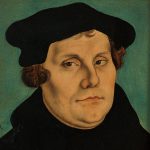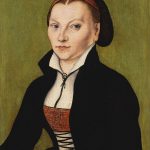By Elliott Brack, editor and publisher | When Martin Luther, the great reformer, comes to mind, you never think of his personal life or his love life. He’s the major figure associated with the beginning of the Protestant Revolution, a figure whose pronouncements even today influence the lives of the world. He’s venerated- — but of course not by the Catholic church.
 We came across a passage about Luther recently, and wanted to know more about his life.
We came across a passage about Luther recently, and wanted to know more about his life.
He was an obscure priest, onetime monk, professor of theology, and composer in a small town about halfway between Potsdam and Dresden in Germany—Wittenburg. His education was at the relatively close University of Erfurt, graduating in 1505.
Becoming upset over some of the practices of the Catholic church, he as a routine university matter nailed his “95 theses” to the door of Wittenburg Cathedral, which was the standard way in those days to start an academic discussion. He had become increasingly doubtful about the tenets of the church, finding much more comfort in the words of the Bible and his own individual faith.
The general date associated with all this is October 31, 1517. Soon Luther found himself in trouble with the higher authorities of the Catholic church, and he was eventually excommunicated. However, Luther, overwhelmed by developments he engendered, quietly continued to write and develop his own system of faith, putting the freedom of believing individuals above the rituals of the church. All along, he enjoyed the protection of his local German ruler, Frederick the Wise.
He said of all this hullabaloo around him: “I would never have thought that such a storm would rise from Rome over one simple scrap of paper.”
Little did he realize that this would become a turning point in that day’s worldwide church, and not only create a theological reformation, but stirring a social revolution as well.
A modern development helped Luther: the printing press had just been invented, and his writings were spread quickly — within three months — over Europe via small pamphlets. This allowed Luther’s thoughts to be discussed widely, and carried with this discussion new ways of thinking, which essentially changed Western civilization, giving rise to today’s ideals of freedom and liberty.
In 1525, Luther married—something not allowed priests by the church—to a former nun who had escaped the convent. Katharina von Bora’s marriage to Luther was scandalous at the time, and is considered the beginning of married clergymen. His “dear Katie” was vivacious and intelligent. Earlier Luther worried that his possible marriage might hurt the reformation movement, then he figured that there were (in his words) many reasons in favor of it for it would “….please his father, rile the Pope, cause the angels to laugh and the devils to weep.”
The Luthers had six children and the family lived in the monastery where he has previously been a monk. Katharina was a good cook, set a fine table, was adept at finances, grew most of their food, brewed their beer, plus was a stimulating conservationist. Luther sought his wife’s view on matters, and with her head for business, she dealt with publishers on his behalf.
It was a good marriage, and full of life. Luther died at age 63 in 1546, after 21 years of marriage. His simple questions and independent thinking led to monumental changes in that day, which have lasted until today.
Martin Luther, (1483-1546): thank you for what you have given the world. May you rest in peace.
- Have a comment? Send to: elliott@brack.net












Follow Us